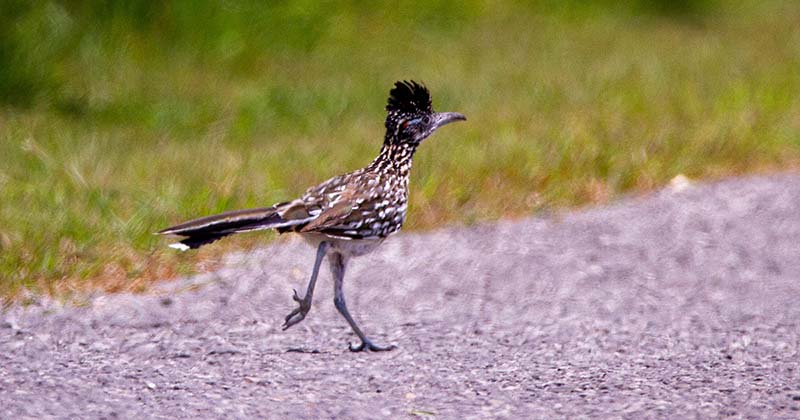In 1949, Warner Bros released Fast and Furry-ous, a Looney Tunes cartoon starring Wile E. Coyote and the Road Runner. Thanks to the Road Runner and his clever ways, always outwitting Wile E. Coyote, many of us attribute qualities of that animated bird to real roadrunners. But the truth is real roadrunners are far more interesting than anything Hollywood could create.
Roadrunners are cuckoos
Roadrunners are part of the cuckoo family or, as Texas Parks and Wildlife Department (TPWD) describes it, “one of the strangest families in the bird world.” Along with other cuckoos and anis, roadrunners share common characteristics including rounded wings, long floppy tails, and a unique track that looks like an “X.” With two toes pointing forward and two pointing back—also known as zygodactyl feet—it’s difficult to tell which way a roadrunner is headed. Just ask Wile E. Coyote. This type of feet also allows them to climb and grasp.
Roadrunners fly (if they must)
A friend of Landmark reported seeing a roadrunner inside her fenced backyard recently. It ran up and down the fence line looking for an exit. Presumably it had entered via a gap on the other side of the yard and now it was looking for an alternate exit. Finally, it flew high enough to land on a fence cross rail, then another, until it made it to the top. She wondered why it wouldn’t just fly over the fence. Roadrunners do fly, don’t they? Yes, but only when they must. Thanks to an ability to run as fast as 25 miles an hour and wings that are shorter and more rounded than other birds, the roadrunner is, understandably, keener to run. Nevertheless, they will fly short distances to perch. As part of their grounded lifestyle, they typically nest 2-12’ above ground in dense bush, low trees, or cacti.
Roadrunners don’t contribute to declining quail populations (but some believe they do)
The Greater Roadrunner is a year-round resident in Texas; its presence has been documented in every county in the state. As noted by the Texas Breeding Bird Atlas, roadrunners were one of the last bird species to be given state protection because of the mistaken belief they contributed to declining quail populations. Why this misconception (and why do some still believe it)? In short, when it comes to food, roadrunners are opportunistic. By way of example, as described in “Naturally Texas: Roadrunners Misunderstood but Protected” a 1982 study conducted in Palo Pinto County showed:
“Insects totaled 75 percent of roadrunner stomach contents. The remaining 14 to 35 percent of items in these particular roadrunners included spiders, scorpions, lizards, snakes, adult birds, bird chicks, bird eggs, ground squirrels, cotton rats, wood rats and juvenile rabbits as well as fruits of tasajillo (turkey pear) and prickly pear cactus.”
So, yes, roadrunners will eat quail if the opportunity presents itself (many of us are personally acquainted with that dining scenario), but they do not target quail. A south Texas study, says Texas Natural Resources Server, “found quail remains in just one of 120 roadrunner stomachs examined.”
Speaking of what (and how) roadrunners eat
Roadrunners have something of a reputation for being able to kill rattlesnakes. And while this reputation may be somewhat inflated, these crafty birds can dispatch a young rattler with a flourish. TPWD shares the roadrunner’s recipe:
“To kill a snake, the road-runner circles around it. Using speed, agility, and quick leaps into the air to stay clear of the snake’s fangs, the bird rushes in and stabs the snake with its pointed beak. Repeated blows stun the snake so it can be seized and slammed against the ground. The bird then pounds it repeatedly against the ground or a rock until the bones in the snake’s head and body are broken or crushed. Lizards and other large prey also are killed and softened in this manner.”
If you are more of a visual person, you can watch a roadrunner “kill and soften” a rattlesnake in this YouTube video by clicking here. If the snake is too long, the bird will swallow what it can, leave the excess hanging outside of its beak, and let its digestive juices work their magic, allowing the remainder of the snake to inch its way inside.
Roadrunners mate for life (and some less charming roadrunner life aspects)
Roadrunners mate for life and, according to a four-year study of 50 roadrunners outfitted with radio transmitters, the males help “in all facets of nesting and feeding the young, including incubating the eggs at night.” Greater Roadrunners breed from early March to late October and may nest as many as three times during a breeding season. If there is not enough food to go around, bigger siblings will cannibalize smaller siblings or eggs.
Roadrunners don’t say beep, beep (or meep, meep)
The cartoon Road Runner’s signature beep beep (although some say it’s meep meep) was inspired by a person’s imitation of a car horn. So how does a real roadrunner vocalize? For the most part, roadrunners coo. All About Birds has a great collection of roadrunner sounds including the coo and the bill rattle during which “both adults and chicks snap the mandibles together to make a sound like castanets.” Listen to the sounds by clicking here.
Although it may not be the real roadrunner’s call, as they coo and play the castanets, for many of us it can be impossible to resist the urge to acknowledge seeing one of these interesting Texas natives dashing down the road with a beep beep!
Photo by Joshua J. Cotten on Unsplash









